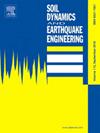Hysteretic and seismic behavior of thick rubber bearings under bidirectional shear loading
IF 4.2
2区 工程技术
Q1 ENGINEERING, GEOLOGICAL
引用次数: 0
Abstract
The behavior of thick rubber bearings (TRBs) is complex because of their thick rubber layers, which are specifically designed to reduce vertical and horizontal vibrations. Although extensive literature supports the benefits of TRBs, there is a lack of research examining the performance of TRBs subjected to the bidirectional shear deformation. Therefore, this study numerically investigates the hysteretic behavior of four full-scale TRBs under bidirectional shear loading, including box, circle, and figure-eight orbits. First, numerical models were developed in ABAQUS software and validated against experimental results by comparing hysteretic curves of TRBs under unidirectional loading, along with data from a single square TRB under bidirectional loading available in the literature. Then, this study examined the effects of bidirectional loading on the effective stiffness and damping ratio of bearings, the shear stress distribution and strain energy of the rubber layers, as well as the Mises stress distribution of the steel shims. The numerical results showed that bidirectional loading altered the shape of the hysteretic curves, particularly under the figure‐eight orbit loading. Bidirectional loading reduced effective stiffness, and increased shear stress at varying shear strains and Mises stress along the steel shims. Finally, the behavior of 10-story building with TRBs under coupled ground motions was investigated. It indicated that bidirectional ground motions significantly increased the horizontal acceleration and deformation of TRBs, as well as their vertical deformation. This led to higher shear stress, strain energy in the rubber layers, and Mises stress in the steel shims compared to unidirectional motion.
求助全文
约1分钟内获得全文
求助全文
来源期刊

Soil Dynamics and Earthquake Engineering
工程技术-地球科学综合
CiteScore
7.50
自引率
15.00%
发文量
446
审稿时长
8 months
期刊介绍:
The journal aims to encourage and enhance the role of mechanics and other disciplines as they relate to earthquake engineering by providing opportunities for the publication of the work of applied mathematicians, engineers and other applied scientists involved in solving problems closely related to the field of earthquake engineering and geotechnical earthquake engineering.
Emphasis is placed on new concepts and techniques, but case histories will also be published if they enhance the presentation and understanding of new technical concepts.
 求助内容:
求助内容: 应助结果提醒方式:
应助结果提醒方式:


